
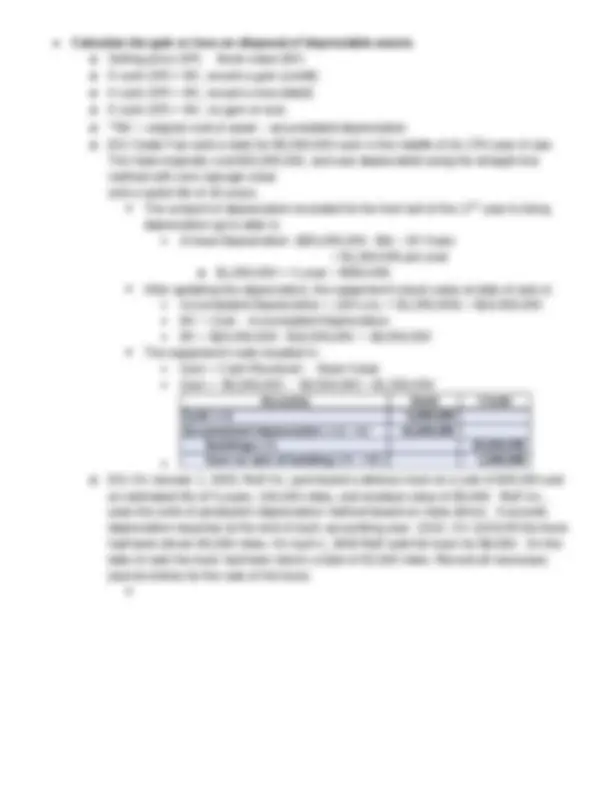
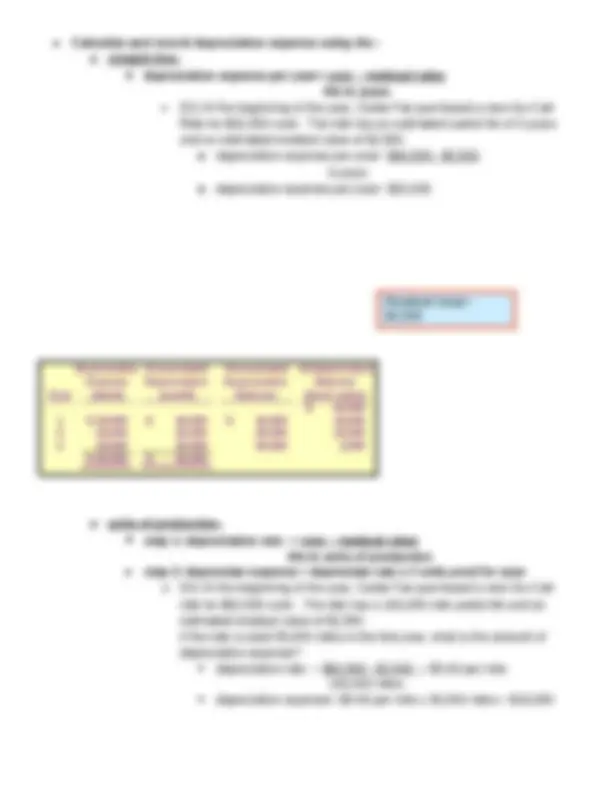
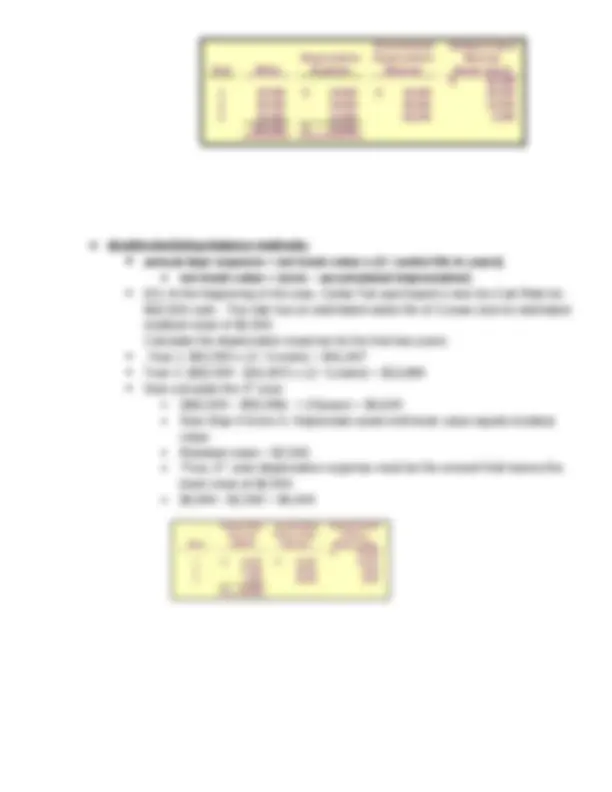
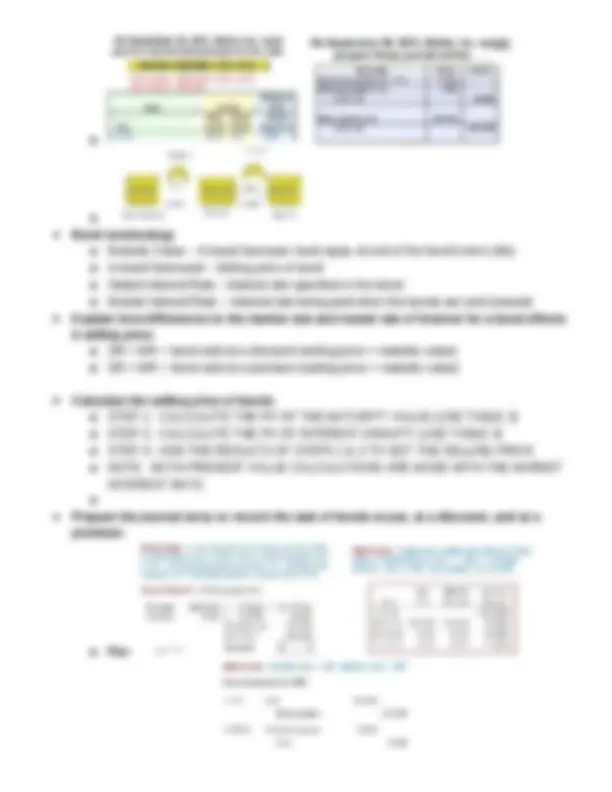
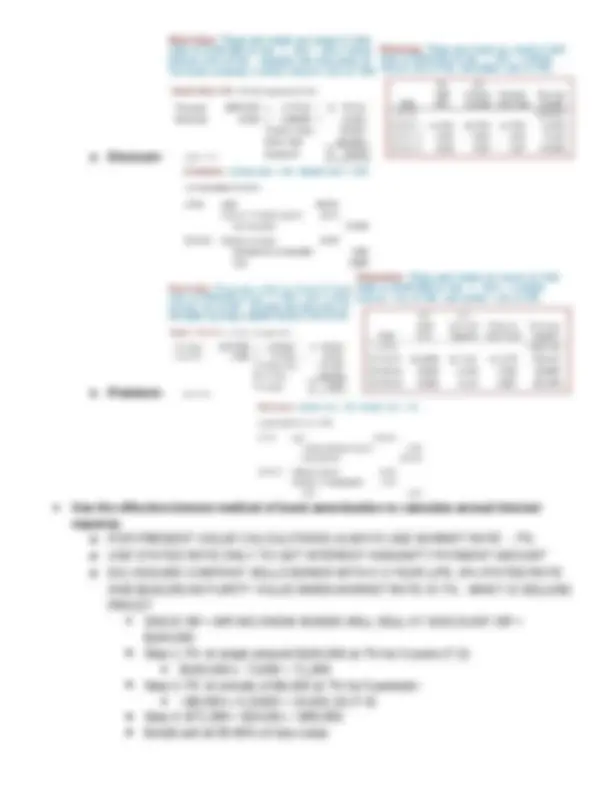
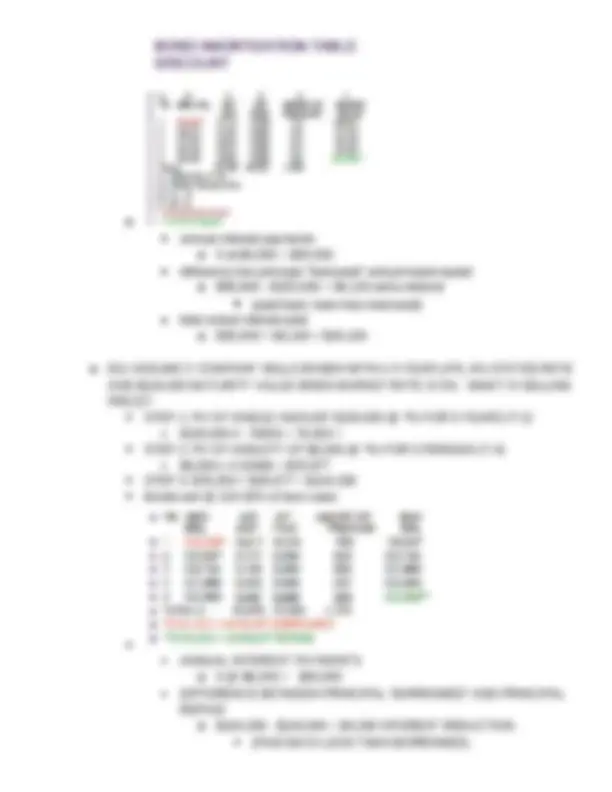
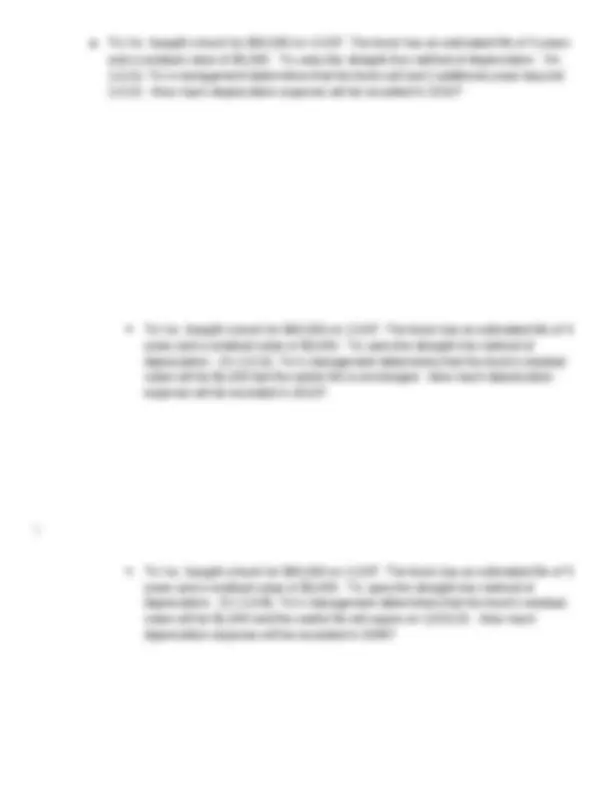
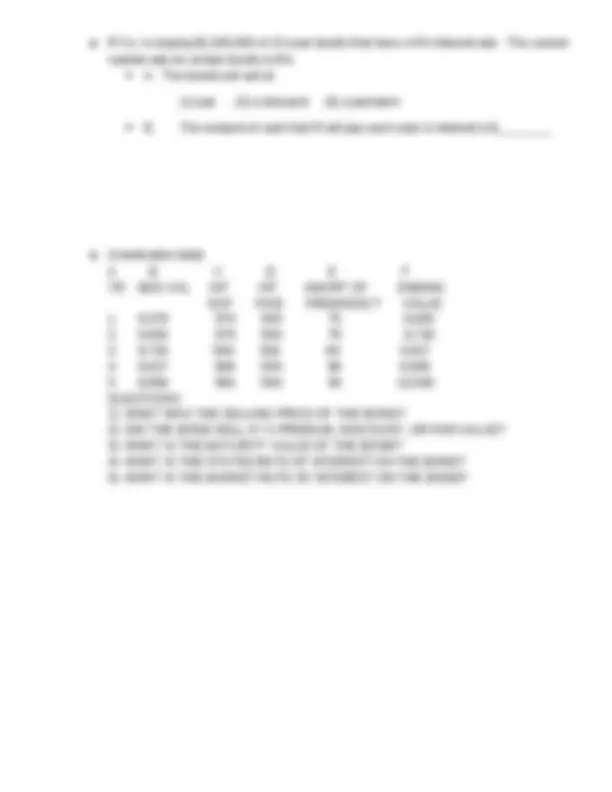


Study with the several resources on Docsity

Earn points by helping other students or get them with a premium plan


Prepare for your exams
Study with the several resources on Docsity

Earn points to download
Earn points by helping other students or get them with a premium plan
Community
Ask the community for help and clear up your study doubts
Discover the best universities in your country according to Docsity users
Free resources
Download our free guides on studying techniques, anxiety management strategies, and thesis advice from Docsity tutors
Test 3 study guide Material Type: Notes; Professor: Winters; Class: FIN ACCT CONCEPTS; Subject: ACCOUNTING; University: Clemson University; Term: Fall 2011;
Typology: Study notes
1 / 14

This page cannot be seen from the preview
Don't miss anything!









The 3rd^ accounting 201 exam is Tuesday, November 15th^ at 7:00 PM. It ends at 8:30 PM. The exam covers chapters 9 & 10 and consists of 30 multiple choice questions, approximately 20 of which require calculations to obtain the answer. To be successful on the exam you should, among other things, be able to CHAPTER 9 Explain the difference between capitalizing and expensing an expenditure o Capitalizing- recording costs as assets—if it extends life beyond original estimate, increases productivity, extends useful life, improvement or expansion o Expensing- if it maintains normal operating condition, does not increase productivity, does not extend life beyond original estimate Describe the concept of goodwill and explain how it is calculated o Goodwill- the amount by which the purchase price exceeds the fair market value of net assets acquired occurs when one company buys another company Only purchased goodwill is an intangible asset Goodwill is not amortized and is subject for impairment value and may be written down EX) Eddy Company paid $1,000,000 to purchase all of James Company’s assets and assumed liabilities of $200,000. The acquired assets were appraised at a fair value of $900,000. What amount of goodwill should be recorded on Eddy Company books? o FMV of Assets $ 900, Debt Assumed 200, FMV of Net Assets $ 700, Purchase Price 1,000, Goodwill $ 300, o o Land- purchase cost, legal fees, surveying fees, brokers commissions o Building- purchase/ construction costs, legal fees, appraisal fees, architectural fees o Equipment- purchase/ construction costs, sales taxes, transportation costs, installation costs Allocate a lump-sum purchase price for several assets, e.g., land, building, & equipment to each of the individual assets using the relative fair market value method o On January 1, Jones purchased land and building for $400,000 cash. The appraised values are building, $325,000, and land, $175,000. How much of the $400,000 purchase price will be charged to the building and land accounts? o
*o Appraised % of Purchase Apportioned Asset Value Value Price Cost a b c b × c Land $ 175,000 35% × $ 400,000= $140, Building 325,000 65% × 400,000 = 260, Total $ 500,000 100% $400,
Calculate and record depreciation expense using the : o straight-line- depreciation expense per year= cost – residual value life in years EX) At the beginning of the year, Cedar Fair purchased a new Go-Cart Ride for $62,500 cash. The ride has an estimated useful life of 3 years and an estimated residual value of $2,500. o depreciation expense per year= $62,500 - $2, 3 years o depreciation expense per year= $20, Depreciation Accumulated Accumulated Undepreciated Expense Depreciation Depreciation Balance Year (debit) (credit) Balance (book value) $ 62, 1 $ 20,000 $ 20,000 $ 20,000 42, 2 20,000 20,000 40,000 22, 3 20,000 20,000 60,000 2, $ 60,000 $ 60, o units-of-production- step 1: depreciation rate = cost – residual value life in units of production step 2: depreciate expense = depreciate rate x # units prod for year o EX) At the beginning of the year, Cedar Fair purchased a new Go-Cart ride for $62,500 cash. The ride has a 100,000 mile useful life and an estimated residual value of $2,500. If the ride is used 30,000 miles in the first year, what is the amount of depreciation expense? depreciation rate = $62,500 - $2,500 = $0.60 per mile 100,000 miles depreciation expense= $0.60 per mile x 30,000 miles = $18, Residual Value= $2,
Accumulated Undepreciated Depreciation Depreciation Balance Year Miles Expense Balance (book value) $ 62, 1 30,000 $ 18,000 $ 18,000 44, 2 50,000 30,000 48,000 14, 3 20,000 12,000 60,000 2, 100,000 $ 60, o double-declining-balance methods- annual depr expense = net book value x (2 / useful life in years) net book value = (cost – accumulated depreciation) EX) At the beginning of the year, Cedar Fair purchased a new Go-Cart Ride for $62,500 cash. The ride has an estimated useful life of 3 years and an estimated residual value of $2,500. Calculate the depreciation expense for the first two years. Year 1: $62,500 x (2 / 3 years) = $41, Year 2: ($62,500 - $41,667) x (2 / 3 years) = $13, Now calculate the 3rd^ year: ($62,500 – $55,556) × 2/3years = $4, Now Step 3 Kicks In: Depreciate asset until book value equals residual value Residual value = $2, Thus, 3rd^ year depreciation expense must be the amount that leaves the book value at $2, $6,944 - $2,500 = $4, Depreciation Accumulated Undepreciated Expense Depreciation Balance Year (debit) Balance (book value) $ 62, 1 $ 41,667 $ 41,667 20, 2 13,889 55,556 6, 3 4,444 60,000 2, $ 60,
Calculate revised depreciation expense based on revised estimates of the asset’s useful life and / or residual value Impact of Depreciation differences Accelerated depreciation, in the early years of an asset’s useful life, results in higher depreciation expense, lower net income, and lower book value than would result using straight-line depreciation. Selling an asset with a low book value , resulting from accelerated depreciation, might result in a gain. Selling the same asset with a higher book value , resulting from straight-line depreciation, might result in a loss. Calculate the fixed asset turnover ratio and interpret its meaning o Fixed asset turnover= net sales revenue Average net fixed assets Measures the sales dollars generated by each dollar invested in fixed assets EX) For the year 2008, Cedar Fair had $1,000,000 of revenue. End-of-year fixed assets were $1,800,000 and beginning-of-year fixed assets were $1,940,000. Fixed asset turnover= $1,000, ($1,800,000 + $1,940,000) / 2 CHAPTER 10 Current liabilities: o Accounts payable- purchase goods or services on credit o Accrued liabilities- an expense is incurred in one acct period, the cash payment in a later period o Notes payable- occurs when one company borrows money from another o Sales tax payable- liability resulting when a company collects sales tax for the state o Unearned revenue- the receipt of cash before goods or services are provided Calculate interest expense on notes payable and record the related adjusting entry at the end of a company’s fiscal year o o
o o Bond terminology o Maturity Value – Amount borrower must repay at end of the bond’s term (life) o Amount Borrowed - Selling price of bond o Stated Interest Rate - Interest rate specified in the bond o Market Interest Rate – Interest rate being paid when the bonds are sold (issued) Explain how differences in the market rate and stated rate of interest for a bond affects it selling price o SR < MR = bond sold at a discount (selling price < maturity value) o SR > MR = bond sold at a premium (selling price > maturity value) Calculate the selling price of bonds o STEP 1: CALCULATE THE PV OF THE MATURITY VALUE (USE TABLE 2) o STEP 2: CALCULATE THE PV OF INTEREST ANNUITY (USE TABLE 4) o STEP 3: ADD THE RESULTS OF STEPS 1 & 2 TO GET THE SELLING PRICE o NOTE: BOTH PRESENT VALUE CALCULATIONS ARE MADE WITH THE MARKET INTEREST RATE o Prepare the journal entry to record the sale of bonds at par, at a discount, and at a premium o Par-
annual interest payments o 5 at $6,000 = $30, difference b/w principal “borrowed” and principal repaid o $95,900 - $100,000 = $4,100 extra interest (paid back more than borrowed) total actual interest paid o $30,000 + $4,100 = $34, o EX) ASSUME X COMPANY SELLS BONDS WITH A 5 YEAR LIFE, 6% STATED RATE AND $100,000 MATURITY VALUE WHEN MARKET RATE IS 5%. WHAT IS SELLING PRICE? STEP 1: PV OF SINGLE AMOUNT $100,000 @ ?% FOR 5 YEARS (T-2) $100,000 X .78353 = 78,353 + STEP 2: PV OF ANNUITY OF $6,000 @ ?% FOR 5 PERIODS (T-4) $6,000 x 4.32948 = $25, STEP 3: $78,353 + $25,977 = $104, Bonds sell @ 104.33% of face value ANNUAL INTEREST PAYMENTS o 5 @ $6,000 = $30, DIFFERENCE BETWEEN PRINCIPAL “BORROWED” AND PRINCIPAL REPAID o $104,330 - $100,000 = $4,330 INTEREST REDUCTION (PAID BACK LESS THAN BORROWED)
o $30,000 - $4,330 = $25, Explain the accounting principles for contingent liabilities to include different likelihoods of loss o Contingent Liability: A potential future obligation that has not yet been determined. o It is dependent on the outcome of a future event. o Example: Ford Motor Co. is being sued because a defect in the steering design of its Mustang model allegedly has caused several accidents resulting in serious injuries and deaths. o Accounting for contingent liabilities is based on the likelihood the company will suffer damages (lose the lawsuit) and the ability to develop a reasonable estimate of the amount of damages. o Calculate compensation expense when income tax, FICA tax, and voluntary deductions are withheld from employee paychecks Sala rie s and w a ges e arned by e mploye es $1,800, Less: Income taxes w ithheld from e mploye es 275, Less: FICA tax es w ithhe ld from e mploye es 105, Net pay to e mploye es $1,420, Ge neral Mills' Payroll Debit Credit Compensation expense (+E, -SE) 1,800, Liability for income taxes withheld (+L) 275, FICA taxes withheld (+L) 105, Cash (-A) 1,420, Compensation expense (+E, -SE) 105, FICA payable (+L) 105, Accounts o EX) During one pay period, your company distributes $127,000 to employees as net pay. The income tax withholdings were $18,415 and the FICA withholdings were $5,080. The total compensation expense to the company during this period was: Net Pay $127,
o Tic Inc. bought a truck for $40,000 on 1/1/07. The truck has an estimated life of 5 years and a residual value of $5,000. Tic uses the straight-line method of depreciation. On 1/1/10, Tic’s management determines that the truck will last 2 additional years beyond 1/1/10. How much depreciation expense will be recorded in 2010? Tic Inc. bought a truck for $40,000 on 1/1/07. The truck has an estimated life of 5 years and a residual value of $3,000. Tic uses the straight-line method of depreciation. On 1/1/10, Tic’s management determines that the truck’s residual value will be $1,000 but the useful life is unchanged. How much depreciation expense will be recorded in 2010?
Tic Inc. bought a truck for $40,000 on 1/1/07. The truck has an estimated life of 5 years and a residual value of $3,000. Tic uses the straight-line method of depreciation. On 1/1/09, Tic’s management determines that the truck’s residual value will be $1,000 and the useful life will expire on 12/31/10. How much depreciation expense will be recorded in 2009?
o R Co. is issuing $1,000,000 of 10 year bonds that have a 6% interest rate. The current market rate for similar bonds is 8%. A. The bonds will sell at (1) par (2) a discount (3) a premium B. The amount of cash that R will pay each year in interest is $________ o Amortization table A B C D E F YR BEG VAL INT INT AMORT OF ENDING EXP PAID PREM/DISC? VALUE 1 9,579 575 500 75 9, 2 9,654 579 500 79 9, 3 9,733 584 500 84 9, 4 9,817 589 500 89 9, 5 9,906 594 500 94 10, QUESTIONS: